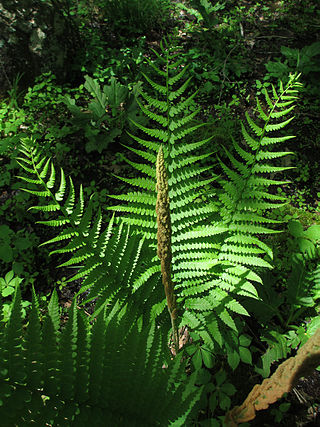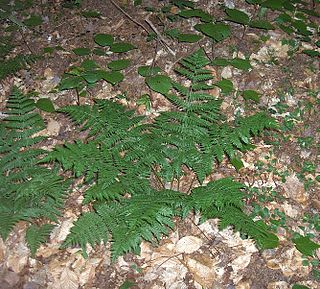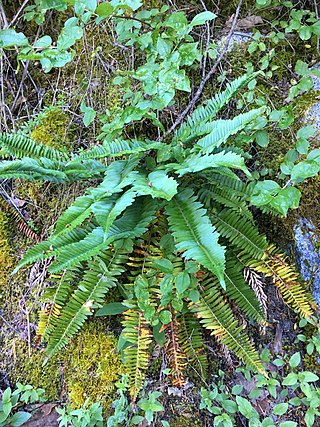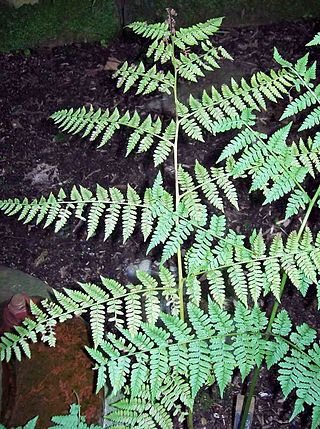
Nephrolepis exaltata, known as the sword fern or Boston fern, is a species of fern in the family Lomariopsidaceae. It is native to the Americas. This evergreen plant can reach as high as 40–90 centimetres (16–35 in), and in extreme cases up to 1.5 metres. It is also known as the Boston sword fern, wild Boston fern, Boston Blue Bell Fern, tuber ladder fern, or fishbone fern.
Sword fern is a common name for several ferns and may refer to:

Onoclea sensibilis, the sensitive fern, also known as the bead fern, is a coarse-textured, medium to large-sized deciduous perennial fern. The name comes from its sensitivity to frost, the fronds dying quickly when first touched by it. It is sometimes treated as the only species in Onoclea, but some authors do not consider the genus monotypic.

Gymnocarpium dryopteris, the western oakfern, common oak fern, oak fern, or northern oak fern, is a deciduous fern of the family Cystopteridaceae. It is widespread across much of North America and Eurasia. It has been found in Canada, the United States, Greenland, China, Japan, Korea, Russia, and most of Europe. It is a seedless, vascular plant that reproduces via spores and have a life cycle with alternating, free-living sporophyte and gametophyte phases.

Polystichum aculeatum, the hard shield-fern, is an evergreen fern native to Europe. It is most abundant in upland regions of the British Isles and western France, where it benefits from the combination of mild winters and moist summers, but also occurs more locally across most of Europe except northern Scandinavia, northern Russia; in the Mediterranean region it is confined to high altitudes. It grows on steep slopes in woodlands. it is sometimes considered an indicator of the presence of ancient woodlands.

Polystichum setiferum, the soft shield fern, is an evergreen or semi-evergreen fern native to southern and western Europe. The stalks and most midribs are coated with attractive cinnamon-brown scales. The Latin specific epithet setiferum means “with bristles”.

Dryopteris affinis, the scaly male fern or golden-scaled male fern, is a fern native to western and southern Europe and southwestern Asia. It is most abundant on moist soils in woodlands in areas with high humidity, such as the British Isles and western France. In the Mediterranean region and the Caucasus it is confined to high altitudes.

Osmundastrum is genus of leptosporangiate ferns in the family Osmundaceae with one living species, Osmundastrum cinnamomeum, the cinnamon fern. It is native to the Americas and eastern Asia, growing in swamps, bogs and moist woodlands.

Polystichum acrostichoides, commonly denominated Christmas fern, is a perennial, evergreen fern native to eastern North America, from Nova Scotia west to Minnesota and south to Florida and eastern Texas. It is one of the most common ferns in eastern North America, being found in moist and shady habitats in woodlands, stream banks and rocky slopes. The common name derives from the evergreen fronds, which are often still green at Christmas.

Polypodium glycyrrhiza, commonly known as licorice fern, many-footed fern, and sweet root, is a summer deciduous fern native to western North America, where it is found in shaded, damp locations.

Dryopteris intermedia, the intermediate wood fern or evergreen wood fern, is a perennial, evergreen wood fern native to eastern North America. It is a diploid species, and is the parent of several species of hybrid origin, including Dryopteris carthusiana. Other common names for this species include intermediate shield fern, fancy wood fern, fancy fern, glandular wood fern, American shield fern and common wood fern.

Amauropelta noveboracensis, the New York fern, is a perennial species of fern found throughout the eastern United States and Canada, from Louisiana to Newfoundland, but most concentrated within Appalachia and the Atlantic Northeast. New York ferns often forms spreading colonies within the forests they inhabit.

Polystichum aleuticum, the Aleutian holly fern or Aleutian shield fern, is an endangered species of the Polystichum genus and currently consisting of a small, vulnerable population endemic found only on Adak Island, Alaska, a remote island of the Aleutian Islands chain in the northern Pacific Ocean. In 1992, 112 specimens existed in the wild, and a recovery plan was implemented.

Polystichum imbricans is a species of fern known by the common names narrowleaf swordfern and imbricate sword fern. It is native to western North America from British Columbia and Idaho to southern California, where it grows in rocky soil and cracks in rock outcrops in coastal and inland mountain ranges and foothills.

Polystichum lonchitis is a species of fern known by the common name northern hollyfern, or simply holly-fern. It is native to much of the Northern Hemisphere from Eurasia to Alaska to Greenland and south into mountainous central North America. It has stiff, glossy green, erect fronds and grows in moist, shady, rocky mountain habitats.

Polystichum scopulinum is a species of fern known by the common names mountain hollyfern and rock sword fern. It is native to much of western North America, and it is known from disjunct occurrences in eastern Canada as well. It grows in rocky habitat, often in full sun. It is widespread but mostly found in small populations, and is noted to be most abundant on serpentine soils. This fern produces several erect, narrowly lance-shaped leaves up to 50 centimeters in length. The leaves narrow near the bases. Each leaf is divided into many lance-shaped or oblong leaflets up to 3 centimeters long. The toothed leaflets are sometimes twisted on their axes and overlapping.

Diplazium australe, commonly known as the Austral lady fern, is a small fern occurring in eastern Australia, New Zealand and Norfolk Island. The habitat is moist shaded areas, often occurring in rainforest.

Adiantum viridimontanum, commonly known as Green Mountain maidenhair fern, is a fern found only in outcrops of serpentine rock in New England and Eastern Canada. The leaf blade is cut into finger-like segments, themselves once-divided, which are borne on the outer side of a curved, dark, glossy rachis. These finger-like segments are not individual leaves, but parts of a single compound leaf. The "fingers" may be drooping or erect, depending on whether the individual fern grows in shade or sunlight. Spores are borne under false indusia at the edge of the subdivisions of the leaf, a characteristic unique to the genus Adiantum.

Polystichum tsus-simense, commonly known as the Korean rock fern, is a perennial herbaceous plant native to East Asia. Its common name corresponds with its ability to grow in shady areas of rock walls. This fern species is a familiar ornamental plant grown in home gardens.

Asplenium tutwilerae is a rare epipetric fern found only in Hale County, Alabama, United States. A. tutwilerae is a fertile allotetraploid, formed by the chromosomal doubling of a specimen of the sterile diploid A. × ebenoides, a hybrid of A. platyneuron and A. rhizophyllum. Except for its spores, which are fertile rather than malformed, A. tutwilerae is essentially identical to A. × ebenoides and was described as part of that species until 2007. It is named in honor of Julia Tutwiler, who discovered the only known wild population at Havana Glen in 1873.























